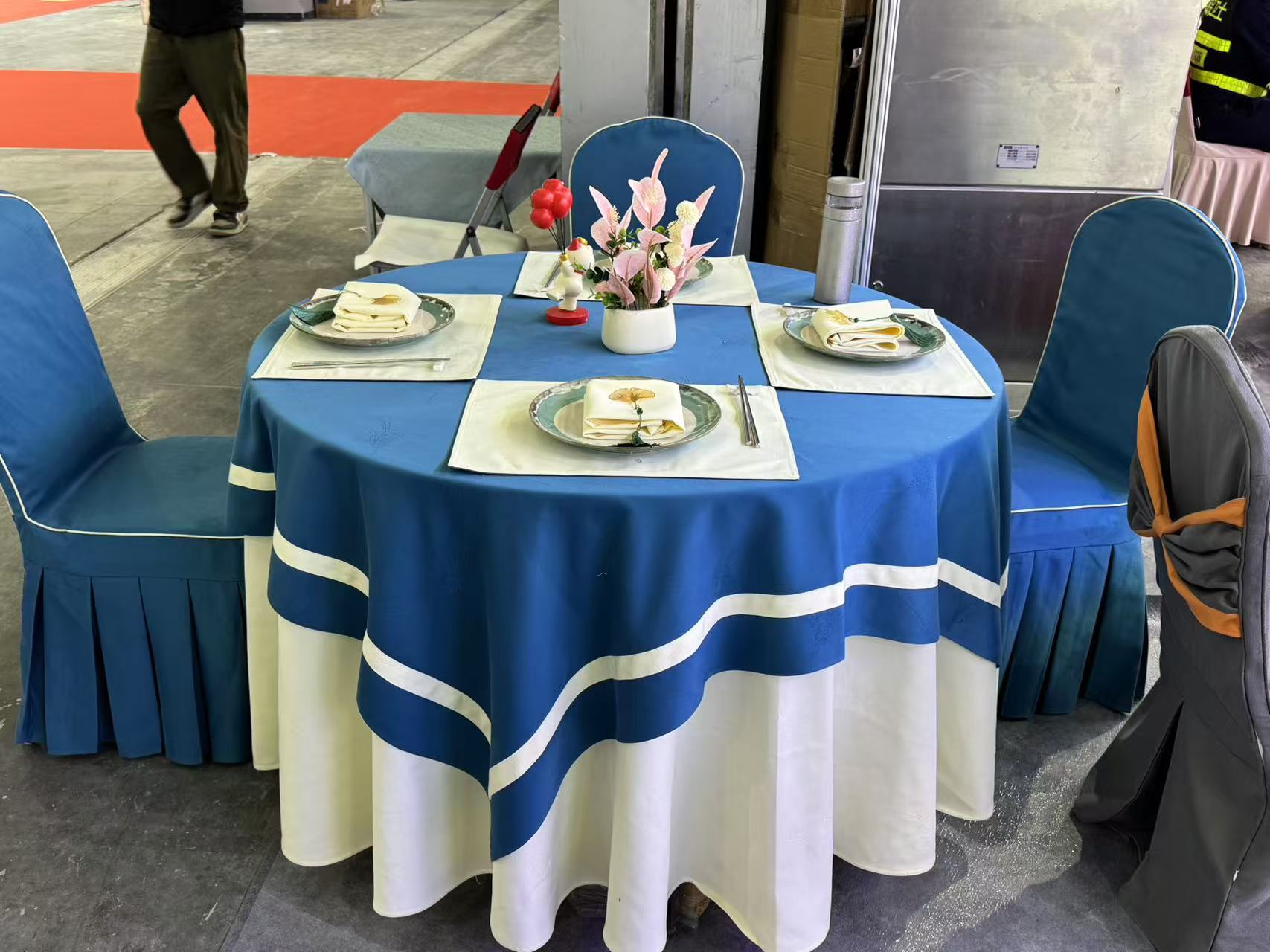酒店布草中需干洗的品類及原因解析
時(shí)間:2025-07-30 來(lái)源:http://www.caibozheng.cn/
酒店布草作為客房、餐飲等區(qū)域的核心紡織品,其清潔方式直接影響使用壽命與美觀度。干洗憑借溶劑去污、低溫處理的特性,成為部分特殊材質(zhì)布草的首選清潔方式。并非所有布草都適合干洗,需根據(jù)材質(zhì)特性、污漬類型及面料要求綜合判斷,以下從常見(jiàn)品類入手解析需干洗的布草及其原因。
As the core textile of guest rooms, catering and other areas, the cleaning method of hotel linen directly affects its service life and aesthetics. Dry cleaning, with the characteristics of solvent cleaning and low-temperature treatment, has become the preferred cleaning method for some special materials of linen. Not all linens are suitable for dry cleaning, and it is necessary to make a comprehensive judgment based on material characteristics, stain types, and fabric requirements. The following will analyze the types of linens that need dry cleaning and their reasons from common categories.
天然高端面料布草:規(guī)避水洗損傷風(fēng)險(xiǎn)
Natural high-end fabric linen: Avoiding the risk of washing damage
羊毛及羊絨制品是典型需干洗的布草。客房?jī)?nèi)的羊毛地毯、羊絨毯等,其纖維表面覆蓋鱗片結(jié)構(gòu),水洗時(shí)遇高溫或機(jī)械攪拌易發(fā)生縮絨反應(yīng),導(dǎo)致面料收縮、變硬,甚至失去彈性。干洗使用的全氯乙烯等溶劑能溫和溶解污漬,避免鱗片相互勾連,同時(shí)保持纖維原有蓬松度。以羊毛地毯為例,干洗后重量損失率可控制在 3% 以內(nèi),而水洗后的收縮率可能超過(guò) 10%,直接影響鋪設(shè)效果。
Wool and cashmere products are typical fabrics that require dry cleaning. Wool carpets, cashmere carpets, etc. in guest rooms are covered with scales on their fiber surfaces. When washed with high temperatures or mechanically stirred, they are prone to shrinkage reactions, resulting in fabric shrinkage, hardening, and even loss of elasticity. The solvents used in dry cleaning, such as vinyl chloride, can gently dissolve stains, avoiding the interlocking of scales while maintaining the original fluffiness of the fibers. Taking wool carpets as an example, the weight loss rate after dry cleaning can be controlled within 3%, while the shrinkage rate after washing may exceed 10%, directly affecting the laying effect.
真絲與桑蠶絲布草同樣依賴干洗保護(hù)。餐廳的真絲臺(tái)布、客房的桑蠶絲床罩等,纖維纖細(xì)且含天然蛋白質(zhì),水洗時(shí)易因堿性洗滌劑侵蝕出現(xiàn)脆化,強(qiáng)光照射后還可能產(chǎn)生泛黃現(xiàn)象。干洗過(guò)程中,溶劑在低溫環(huán)境下快速帶走污漬,配合中性助劑可減少蛋白質(zhì)流失,使面料保持柔軟光澤。這類布草若強(qiáng)行水洗,不僅手感變差,使用壽命可能縮短一半以上。
Silk and mulberry silk cloth both rely on dry cleaning protection. The silk tablecloths in restaurants and the mulberry silk bed covers in guest rooms are made of fine fibers and contain natural protein. They are prone to becoming brittle when washed with alkaline detergents, and may also turn yellow under strong light. During the dry cleaning process, the solvent quickly removes stains in a low-temperature environment, and when combined with neutral additives, it can reduce protein loss and keep the fabric soft and shiny. If this type of linen is forcibly washed, not only will the hand feel deteriorate, but its service life may also be shortened by more than half.

結(jié)構(gòu)復(fù)雜或帶特殊工藝的布草:保護(hù)造型與功能性
Fabric with complex structure or special craftsmanship: protecting shape and functionality
帶有立體刺繡、蕾絲花邊的布草需優(yōu)先選擇干洗。客房裝飾用的刺繡窗簾、餐飲區(qū)的蕾絲桌旗等,其刺繡線與面料纖維可能存在染色牢度差異,水洗時(shí)易發(fā)生串色;蕾絲的鏤空結(jié)構(gòu)在機(jī)械洗滌中可能被勾扯變形,破壞原有花紋完整性。干洗通過(guò)手工預(yù)處理污漬、輕柔溶劑循環(huán)的方式,既能去除局部油污,又能避免刺繡線斷裂、蕾絲抽絲,尤其適合高端酒店的裝飾性布草。
Linen with three-dimensional embroidery and lace should be given priority for dry cleaning. Embroidered curtains used for guest room decoration and lace table flags in the dining area may have differences in color fastness between the embroidery thread and the fabric fibers, which can easily cause color bleeding during washing; The hollow structure of lace may be torn and deformed during mechanical washing, damaging the integrity of the original pattern. Dry cleaning, through manual pre-treatment of stains and gentle solvent circulation, can not only remove local oil stains, but also avoid embroidery thread breakage and lace pulling, especially suitable for decorative linens in high-end hotels.
復(fù)合面料布草也需依賴干洗維持結(jié)構(gòu)穩(wěn)定。部分窗簾采用 “面料 + 遮光層” 的復(fù)合設(shè)計(jì),遮光層多為涂層材質(zhì),水洗時(shí)可能因水溫變化出現(xiàn)脫層、起泡;沙發(fā)套等使用的麂皮絨復(fù)合布,面料與底層基布的收縮率不同,水洗后易產(chǎn)生褶皺、起翹。干洗溶劑的滲透性強(qiáng)且無(wú)水分參與,可減少不同材質(zhì)間的張力差異,確保復(fù)合布草保持平整貼合的狀態(tài)。
Composite fabrics and linens also rely on dry cleaning to maintain structural stability. Some curtains adopt a composite design of "fabric+shading layer", and the shading layer is mostly a coating material. During washing, delamination and foaming may occur due to changes in water temperature; The suede composite fabric used for sofa covers has a different shrinkage rate from the underlying base fabric, and is prone to wrinkles and warping after washing. The dry cleaning solvent has strong permeability and no involvement of moisture, which can reduce the tension difference between different materials and ensure that the composite linen maintains a flat and snug state.
特殊污漬污染的布草:提升頑固污漬去除率
Cloth contaminated with special stains: improving the removal rate of stubborn stains
沾染油脂類污漬的布草更適合干洗處理。餐飲區(qū)的臺(tái)布、餐巾常接觸動(dòng)植物油脂、調(diào)味醬等,這類污漬含脂肪酸成分,水洗時(shí)易與水中鈣鎂離子結(jié)合形成皂垢,殘留在面料上形成淡黃色斑跡。干洗溶劑對(duì)油脂的溶解力是水的 5-8 倍,能快速瓦解油污分子,尤其對(duì)黃油、橄欖油等凝固性油脂,去污效果遠(yuǎn)優(yōu)于水洗。
Cloth contaminated with grease stains is more suitable for dry cleaning. Tablecloths and napkins in the dining area often come into contact with vegetable oils, sauces, etc. These stains contain fatty acid components, which can easily combine with calcium and magnesium ions in the water to form soap stains when washed, leaving light yellow spots on the fabric. The solubility of dry cleaning solvents for oils and fats is 5-8 times that of water, which can quickly dissolve oil molecules, especially for solidified oils and fats such as butter and olive oil. The cleaning effect is much better than that of water washing.
含化妝品或染料的污漬需通過(guò)干洗處理。客房的床單、枕套可能沾染客人的護(hù)膚品、染發(fā)劑等,其中的礦物油成分與色素在水中易擴(kuò)散,導(dǎo)致污漬面積擴(kuò)大。干洗時(shí),溶劑可先溶解油脂載體,再通過(guò)吸附劑帶走色素分子,減少污漬殘留。例如口紅污漬,干洗前用專用去漬劑預(yù)處理,再經(jīng)溶劑循環(huán)清洗,去除率可達(dá) 90% 以上,而水洗后往往留下難以消除的淡紅色印記。
Stains containing cosmetics or dyes need to be treated by dry cleaning. The bed sheets and pillowcases in guest rooms may be contaminated with guests' skincare products, hair dyes, etc. The mineral oil components and pigments in them can easily spread in water, leading to the expansion of the stain area. When dry cleaning, the solvent can first dissolve the oil carrier, and then remove the pigment molecules through the adsorbent to reduce the residue of stains. For example, lipstick stains can be pre treated with a specialized stain remover before dry cleaning, and then cleaned by solvent circulation, with a removal rate of over 90%. However, after washing with water, they often leave difficult to eliminate light red marks.
本文由濟(jì)南酒店布草友情奉獻(xiàn).更多有關(guān)的知識(shí)請(qǐng)點(diǎn)擊:http://www.caibozheng.cn真誠(chéng)的態(tài)度.為您提供為全面的服務(wù).更多有關(guān)的知識(shí)我們將會(huì)陸續(xù)向大家奉獻(xiàn).敬請(qǐng)期待.
This article is a friendly contribution from the hotel linen For more information, please click: http://www.caibozheng.cn Sincere attitude To provide you with comprehensive services We will gradually contribute more relevant knowledge to everyone Coming soon.
資訊推薦Information
聯(lián)系我們Information
